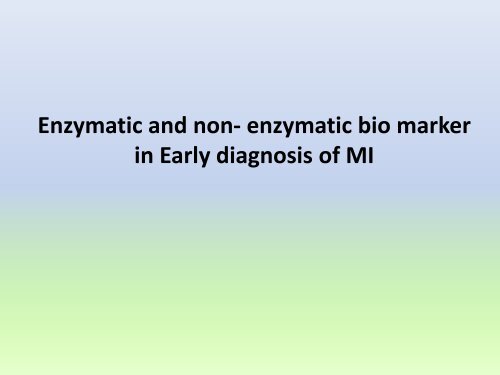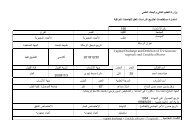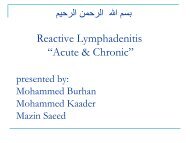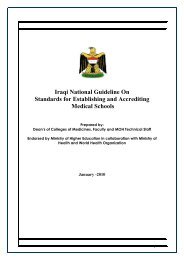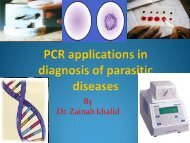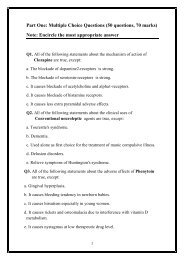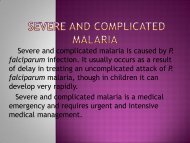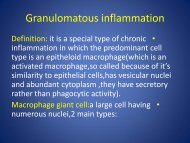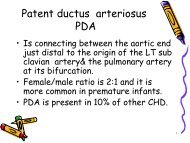Enzymatic and non- enzymatic bio marker in Early diagnosis of MI
Enzymatic and non- enzymatic bio marker in Early diagnosis of MI
Enzymatic and non- enzymatic bio marker in Early diagnosis of MI
You also want an ePaper? Increase the reach of your titles
YUMPU automatically turns print PDFs into web optimized ePapers that Google loves.
<strong>Enzymatic</strong> <strong>and</strong> <strong>non</strong>- <strong>enzymatic</strong> <strong>bio</strong> <strong>marker</strong><strong>in</strong> <strong>Early</strong> <strong>diagnosis</strong> <strong>of</strong> <strong>MI</strong>
A cute myocardial <strong>in</strong>farction (A<strong>MI</strong>) is thelead<strong>in</strong>g cause <strong>of</strong> death <strong>in</strong> developedcountries; however, hospital mortalityfrom this cause has been decl<strong>in</strong><strong>in</strong>g overthe last three decades.this reduction <strong>in</strong>mortality co<strong>in</strong>cides with the improvement<strong>in</strong> health <strong>and</strong> liv<strong>in</strong>g st<strong>and</strong>ards <strong>and</strong> withnew treatments like thrombolysis
And new <strong>in</strong>terventions likepercutaneous coronary <strong>in</strong>terventions(PCI) <strong>and</strong> coronary artery bypassgraft<strong>in</strong>g(CABG).
The success <strong>of</strong> treatment rests on:identification <strong>of</strong> patients <strong>in</strong> the veryearly stages <strong>of</strong> A<strong>MI</strong>
The ideal characteristics <strong>of</strong> a <strong>marker</strong><strong>of</strong> myocardial <strong>in</strong>jury are: it should beabundant <strong>in</strong> the myocardium <strong>and</strong> notpresent <strong>in</strong> other tissues. This gives it ahigh specificity for the myocardium<strong>and</strong> reduces the rate <strong>of</strong> false positiveresults.
Cardiac <strong>marker</strong>s play an importantrole <strong>in</strong> the detection <strong>of</strong> A<strong>MI</strong> when thepatients history <strong>and</strong> ECG are <strong>non</strong>diagnostic
Cardiac <strong>bio</strong><strong>marker</strong>s• CK-MB is the heart spesificisoenzyme <strong>and</strong> has been the goldst<strong>and</strong>ard enzyme for the <strong>diagnosis</strong><strong>of</strong> A<strong>MI</strong>.
Myoglob<strong>in</strong>• A prote<strong>in</strong> found <strong>in</strong> striated skeletal <strong>and</strong>cardiac muscles, myoglob<strong>in</strong> is an early <strong>marker</strong><strong>of</strong> <strong>in</strong>jury to muscle tissue. A rise <strong>in</strong> myoglob<strong>in</strong>concentration is detectable <strong>in</strong> blood as earlyas 1 to 3 hours after the onset <strong>of</strong> <strong>MI</strong>symptoms <strong>and</strong> can be used to rule out the<strong>diagnosis</strong> <strong>in</strong> the 2 to 6 hours period after Theonset <strong>of</strong> symptoms.the disadvantage <strong>of</strong>myoglob<strong>in</strong> is that it is not cardiac specific.
It can be <strong>in</strong>creased <strong>in</strong> trauma,diseases <strong>of</strong> theskeletal muscles,<strong>and</strong> renal failure. Myoglob<strong>in</strong>concentrations for adult men range from 30 to90 ng/dL; women typically demonstrateconcentrations <strong>of</strong> less than 50 ng/mL.Myoglob<strong>in</strong> can be measured by latexagglut<strong>in</strong>ation,enzyme-l<strong>in</strong>ked immunosorbentassay(ELISA),immu<strong>non</strong>ephelometry,<strong>and</strong>fluoroimmunoassy.A spot test us<strong>in</strong>gimmunochromatography is also available.
tropon<strong>in</strong>s• Tropon<strong>in</strong>s is a complex <strong>of</strong> three prote<strong>in</strong>sthat b<strong>in</strong>d to the th<strong>in</strong> filaments <strong>of</strong>striated cardiac or skeletal muscle <strong>and</strong>regulated muscle concetraction. Thecomplex consist <strong>of</strong> the follow<strong>in</strong>g :• Tropon<strong>in</strong> T (TnT)• Tropon<strong>in</strong> I (TnI)• Tropon<strong>in</strong> C (TnC)
Tropon<strong>in</strong> I rema<strong>in</strong> <strong>in</strong>vated <strong>in</strong>blood for 4 to 10 days after <strong>MI</strong> <strong>and</strong>thus is valiable for late present<strong>in</strong>gpatients.
Heart-type acid-b<strong>in</strong>d<strong>in</strong>g prote<strong>in</strong> test<strong>in</strong> the prehospital diagnostic test <strong>of</strong>acute myocardial <strong>in</strong>farction.
Copept<strong>in</strong> the release pattern <strong>of</strong>copept<strong>in</strong> <strong>in</strong> patients with A<strong>MI</strong> withimmediate rise after onset <strong>of</strong> chestpa<strong>in</strong> <strong>and</strong> decrease toward physiologiclevels with<strong>in</strong> 5 days.
Myeloperoxidase, but not C-reactiveprote<strong>in</strong>, predicts cardiovascular risk <strong>in</strong>peripheral arterial disease, althoughC-reactive prote<strong>in</strong> is a predictor <strong>of</strong><strong>in</strong>flamatory changes .
Previous Cardiac <strong>marker</strong>s:1- Sgot(Ast).2- LDH.3- Total cpk.


